Cardenio
William Shakespeare and John Fletcher (1613)
Historical Records
Accounts of the Treasurer of the Chamber
Item paid to the said Iohn Heminges vppon the lyke warrant: dated att Whitehall xx0 die Maij 1613 for presentinge sixe severall playes viz one playe called a badd ‡ beginininge makes a good endinge, One other called ye Capteyne, One other the Alcumist. One other Cardenno. One other The Hotspurr. And one other called Benidicte and Bettris All played wthin the tyme of this Accompte viz pd Fortie powndes, And by waye of his Mates rewarde twentie powndes In all …… lxli (Item 47b [Cook 56])
Item paid to Iohn Heminges vppon lyke warr': dated att Whitehall ix0 Die Iulij 1613 for him self and the rest of his fellowes his Mate servauntes and Players for presentinge a playe before the Duke of Savoyes Embassadour on the viijth Daye of Iune 1613 called Cardenna the some of …… vjli xiijs iiijd (Item 47a [Cook 55])
Stationers' Register
09 September 1653 (S.R.II, 1.428 CLIO)
- Master Mosely Entred also . . . the severall playes following . . xxs vjd
- The history of Cardenio, by Mr Fletcher & Shakespeare.
Unnoted in Arber's transcript is a full stop after "Fletcher" in the register itself.
Theatrical Provenance
The play was performed by the King's Men at court in the 1612-13 season, with payments on 20 May pertaining to a Whitehall performance of uncertain date following Christmas, and for 09 July 1613 (pertaining to a performance which occurred on 08 June 1613 at Greenwich) (Astington 246-47). The company had leases at both the Globe and the Blackfriars at this time.
Possible Genre
The play is listed as a "History" in Moseley's entry in the Stationers' Register. Lewis Theobald's 1727 play Double Falsehood, which may be an adaptation of a version of Cardenio (see below), is a sentimental romantic tragicomedy. The "Cardenio" episodes of Cervantes' Don Quixote are framed within a parodic romance, but it is not known whether elements of the parody were retained in the play.
Possible Narrative and Dramatic Sources or Analogues
Cardenio in Don Quixote
Based on the title, and on the plot extant in Double Falsehood, most scholars agree that Cardenio is a dramatisation of the "Cardenio" episodes from Miguel de Cervantes's Don Quixote. Thomas Shelton's translation of the first part of the novel was published in 1612 and available to the King's Men as a direct source.
In Cervantes, the deluded Alonso Quesada rechristens himself Don Quixote, knight errant, and with his "squire" Sancho Panza embarks on a chivalric quest through contemporary Spain. During their adventures, they encounter a madman called Cardenio, who has been living in the hills since his betrayal by his noble friend, the Duke Fernando. Fernando had promised marriage to the modest Dorothea, but forsaken her in his pursuit of Cardenio's love, Luscinda. Dorothea similarly lives in the hills, disguised. The Cardenio narrative is interwoven with Quixote's adventures, and Dorothea is recruited by neighbours of Don Quixote to persuade him to return home. Eventually, Cardenio is reconciled to Luscinda and Fernando to Dorothea.
In 1727, Lewis Theobald's play Double Falsehood premiered at Covent Garden, and it was published the following year. Theobald's play, which purports to be "Revised and Adapted" from an original play by Shakespeare, dramatises the Cardenio story only with no mention of the Don Quixote plot. Here, the action is streamlined. Henriquez (Fernando) rapes Violante (Dorothea) and attempts to forcibly wed Leonora (Luscinda), but is prevented by Julio's (Cardenio's) interruption. Julio and Violante meet in the wilderness, and the eventual reconciliation is brought about by Roderick, Henriquez's elder brother.
Cardena in Spain
Tiffany Stern has argued that Cardenna could theoretically refer to Cardena in Spain, and thus bear no connection to the Cervantes story (556-57).
References to the Play
Following Moseley's entry in the S.R., the entry is repeated in an assignment of copyrights sold to Jacob Tonson the Younger on 5 April 1718 (Hammond 81). There are no other early references to the play by this title.
The next documented occurrence related to the play was the first performance of Lewis Theobald's play Double Falsehood at Covent Garden on 13 December 1727. Theobald's preface makes no explicit mention of Cardenio by name (character or play), but acknowledges the play's source in Cervantes. He claims to have three manuscript copies of the play, including one
"of above sixty years' standing, in the handwriting of Mr Downes, the famous old prompter; and as I am credibly informed, was early in the possession of the celebrated Mr Betterton, and by him designed to have been ushered into the world" (reproduced in Hammond 167-8).
If true, this suggests that a version of the play was owned by the Duke's Company immediately following the reopening of the theatres in 1660. The afterlife of Cardenio stems from Theobald's play.
Critical Commentary
Critical commentary has largely concentrated on establishing whether or not Theobald's play is a genuine adaptation of a Shakespeare/Fletcher play, an adaptation of a different work, or a forgery.
The case for forgery
...is upheld by Harriet C. Frazier, Jeffrey Kahan and, most fully, by Tiffany Stern. Skeptics point to inconsistencies in Theobald's description of the sources he possessed, and the lack of evidence that anyone ever saw them, and to Theobald's failure to include it in his own subsequent edition of Shakespeare. The contemporary skepticism of Alexander Pope, who ridiculed Theobald in his Dunciad with explicit reference to Double Falsehood, is cited as evidence that the attribution was not taken seriously even in the 1720s. Hammond's evidence that the Tonsons owned a catalogue including Moseley's reference to Cardenio suggests that Theobald could have been aware of the lost play. Stern points out that Theobald frequently turned to Don Quixote for material, and that his editorial work included Fletcher as well as Shakespeare, accounting for apparent similarities in style.
John Freehafer suggests that the full stop after "Fletcher" in the Stationers' Register entry may suggest that "& Shakespeare" was an "afterthought" by Moseley (Freehafer 508).
The case for Theobald's honesty
...was first advanced by Gamaliel Bradford Jr. in 1910, and has been supported by Freehafer, Stephan Kukoski, Jonathan Bate, A. Luis Pujante, Gary Taylor and Richard Proudfoot, among others. Key points in the argument include the apparent unawareness of a lost play about Cardenio, and thus the improbability of Theobald independently creating a play on the subject; linguistic parallels with Shakespeare and, most significantly, with Fletcher, whom Theobald only belatedly acknowledged as a possible collaborator; and the likeness of the play to others performed around 1613 (notably Cymbeline, The Winter's Tale and The Two Noble Kinsmen). Theobald's exclusion of the play from his edition of Shakespeare is usually explained as a result of Pope's attacks, with the preface to the second issue of the published play suggesting that Theobald himself was losing confidence in the attribution. A report of 31 March 1770 reports that the "original Manuscript" of Double Falsehood was stored in the Museum of Covent Garden Playhouse, and it is conjectured that Theobald's manuscripts may have perished when the building burned down on 19 September 1808.
Belief in Theobald's veracity has been qualified by the further possibility that he was working from a Restoration adaptation of the play rather than from a Jacobean original, a position strengthened by Theobald's own admission that one of his manuscripts is in the hand of the Duke's Company prompter John Downes (See Theobald, "Preface", and Hammond 48-58). Comparison of the collaborative The Two Noble Kinsmen with William Davenant's 1668 adaptation of the play as The Rivals indicates the scale of revision deemed necessary for a Restoration audience, excising Shakespeare almost entirely. Few critics claim that substantial chunks of Shakespeare or Fletcher's poetry remain in Double Falsehood.
In 2010, Double Falsehood was published in the Arden Shakespeare, the first treatment of the play in a full critical edition as part of a Shakespeare series. Subsequent critical discussion has been polarised as a result of this decision. The publication also prompted debate in the mass media, as well as several productions of Double Falsehood and reconstructions of Cardenio, most notably by Gregory Doran for the Royal Shakespeare Company.
"Woods, rocks and mountains" (music)
Robert Johnson (c.1583–1633), lutenist to the King from 1604 onwards, composed music for the King's Men from 1607 onwards. This included songs for The Winter's Tale, Cymbeline and The Tempest by Shakespeare, as well as for plays by Fletcher, Middleton, Webster and possibly for such lost plays as Tourneur's "The Nobleman" and Fletcher, Field and Massinger's "The Jeweller of Amsterdam". Amongst the ten surviving Johnson songs not explicitly assigned to any particular play, the madrigal known as "Woods, rocks and mountains" has been proposed (by historian Michael Wood in his unpublished MS, 2001) as having origins in the lost "Cardenio" (see below). A modernised version of the lyrics is included in 4.2 of the "Cardenio" fragment (Gary Taylor's reconstructed text based on the Theobald play) in Gary Taylor, John Jowett, Terri Bourus, and Gabriel Egan (eds), The New Oxford Shakespeare: Modern Critical Edition, as follows:
Woods, rocks, and mountains, and ye desert places
Where naught but bitter cold and hunger dwells,
Hear a poor maid's last will killed with disgraces.
Slide softly while I sing, ye silver fountains,
And let your hollow waters like sad bells
Ring, ring to my woes, while miserable I,
Cursing my fortunes, drop, drop, drop a tear and die.
Griefs, woes, and groanings, hopes and all such liars
I give to broken hearts that daily weep;
To all poor maids in love, my lost desires.
Sleep sweetly, while I sing my bitter moanings,
And list may hollow lovers, that ne'er keep
Truth, truth in their hearts, while miserable I,
Still cursing my fortunes, drop, drop, drop a tear and die.
Numerous copies of the music survive:
BL Add. MS. 11608, fol. 15v–16r (reproduced here by permission of the British Library) includes the second stanza, which is not found in other transcriptions:

|

|
| British Library Add. MS. 11608, fol. 15v. | British Library Add. MS. 11608, fol. 16r. |
Christ Church, Oxford has the earliest (c.1620) transcription: Ch. Ch. MSS Mus 56-60, no.56, a musical manuscript comprised of five partbooks. Item 56 ("Woods, rocks and mountains") is reproduced below with kind permission of The Governing Body of Christ Church.
This music has been professionally recorded for the Lost Plays Database by Ludovico's Band and mezzo-soprano Sally-Anne Russell, using modern copies of historical instruments (Marshall McGuire - triple harp, Shane Lestideau - baroque violin, Samantha Cohen - theorbo, and Ruth Wilkinson - viola da gamba). Recorded in the Salon, Melbourne Recital Centre on December 15, 2016 (sound engineer: Alex Stinson). Press play below to hear this musical fragment:
Html5mediator: error loading file:"Ludovico\u0026#039;s_Band_-_Woods,_Rocks_and_Mountains_48k-16b.mp3"
56
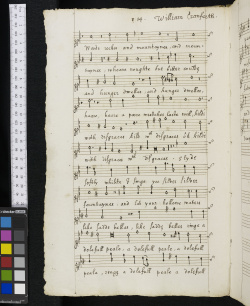
|
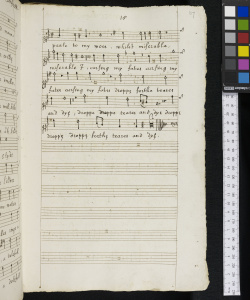
|
| Ch. Ch. MSS Mus 56, no.56, p. 136. | Ch. Ch. MSS Mus 56, no.56, p. 137. |
57
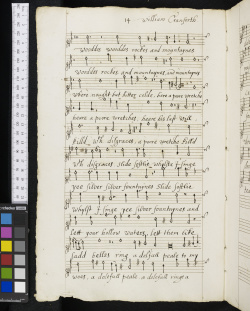
|
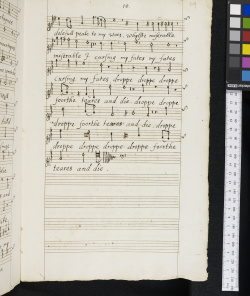
|
| Ch. Ch. MSS Mus 57, no.56, p. 118. | Ch. Ch. MSS Mus 57, no.56, p. 119. |
58
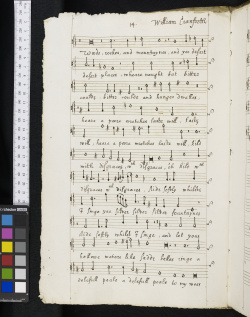
|
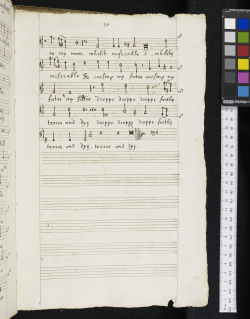
|
| Ch. Ch. MSS Mus 58, no.56, p. 14. | Ch. Ch. MSS Mus 58, no.56, p. 15. |
59
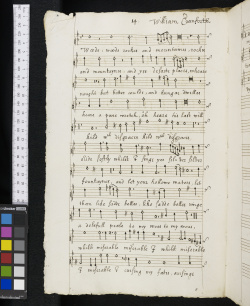
|
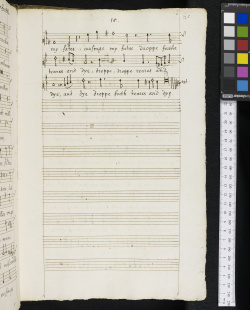
|
| Ch. Ch. MSS Mus 59, no.56, p. 124. | Ch. Ch. MSS Mus 59, no.56, p. 125. |
60

|
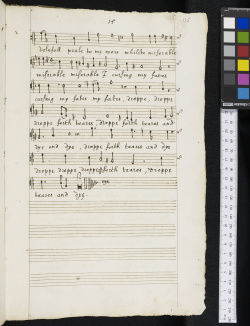
|
| Ch. Ch. MSS Mus 60, no.56, p. 134. | Ch. Ch. MSS Mus 60, no.56, p. 135. |
Focusing on Edmund Gayton's Pleasant Notes upon Don Quixot (1654), Gary Taylor notes that "Gayton does clearly imagine music and singing where Cervantes does not, at the very point in the story that seems to have prompted the Robert Johnson song. The words of that song are stylistically and statistically Fletcherian. Moreover, Gayton was thinking of Beaumont and Fletcher when he wrote about this episode of the novel, referring to ‘Cardenio’ and ‘Philaster’ in the same sentence" (36). Taylor argues that the lyrics were written by Fletcher specifically (30-32). Noting that the generic elements of the song are inconclusive in terms of a positive identification of its origins, Taylor proceeds to observe that "other details are more unusual":
Through direct address to woods, rocks, mountains, and ‘desert’ (deserted, inhospitable) places, the song locates the singer in a specific setting, one also associated with cold and hunger. This description exactly fits the Sierra Morena, into which both Dorothea and Cardenio flee in Don Quixote. Both in love, both have been betrayed by more than one person they trusted. But the other remarkable feature of the setting, specified by the lyric, is the presence of abundant and noisy water: ‘silver fountains’ and ‘hollow waters’. Dorothea enters the novel when she is discovered, in the Sierra Morena mountains, ‘behinde a rocke’, washing her feet ‘in the cleere streame that glided that way’. She is alone, and her first words (like the first words of the song) address ‘the solitarinesse of these rockes’ and the ‘cragges and thickets’ which she intends to be her ‘Sepulchre’. Dorothea, like the singer of this song, expects to die in this place. She ‘communicates [her] mishaps to heaven’ alone, because she trusts ‘none upon earth’ (DQ, 385). The scene thus combines mountains, woods, rocks, a deserted place, a despairing, solitary speaker with her feet in moving water, whose tale (told in the following pages of the same chapter) involves just the sort of romantic betrayal, falsehood, and disgrace described in this song. Beyond the scenario and setting of this single page, much of the song’s vocabulary can be found in Shelton’s 1612 translation. No other scene in a dramatic work by the King’s Men from Johnson’s song-writing years so perfectly matches this lyric. The song therefore appears to be a fragment of the lost play.(29)
For What It's Worth
A discredited argument, advanced by Charles Hamilton in 1994, is that the untitled manuscript play known variously as The Second Maiden's Tragedy, The Lady's Tragedy or The Maiden's Tragedy is Cardenio. Hamilton's argument depends on that play's source in Don Quixote, in a story interwoven with (but independent of) the Cardenio plot; and on Hamilton's identification of the handwriting in the manuscript with Shakespeare's extant signatures. Hamilton's case has met with little academic support, but The Second Maiden's Tragedy is still occasionally revived under the title Cardenio.
While several productions entitled Cardenio have been performed in recent years, such as those by Stephen Greenblatt and Charles Mee (American Repertory Theatre, Cambridge MA, 2008), Gary Taylor (Wellington, 2009) and Gregory Doran (Royal Shakespeare Company, 2011), it should be borne in mind that these are conjectural reconstructions based on a combination of Shelton's Don Quixote and Theobald's Double Falsehood, and thus bear no direct historical relation to the lost play.
Works Cited
Site created and maintained by Peter Kirwan, University of Nottingham, 29 December 2011; updated by David McInnis, 06 January 2017.